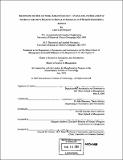| dc.contributor.advisor | R. John Hansman and Thomas Kochan. | en_US |
| dc.contributor.author | Bogusch, Laura Lynn, 1973- | en_US |
| dc.contributor.other | Leaders for Manufacturing Program. | en_US |
| dc.coverage.spatial | n-us-il | en_US |
| dc.date.accessioned | 2008-01-10T16:19:26Z | |
| dc.date.available | 2008-01-10T16:19:26Z | |
| dc.date.copyright | 2003 | en_US |
| dc.date.issued | 2003 | en_US |
| dc.identifier.uri | http://hdl.handle.net/1721.1/40025 | |
| dc.description | Thesis (S.M.)--Massachusetts Institute of Technology, Sloan School of Management; and, (S.M.)--Massachusetts Institute of Technology, Dept. of Aeronautics and Astronautics; in conjunction with the Leaders for Manufacturing Program at MIT, 2003. | en_US |
| dc.description | Includes bibliographical references (p. 79-80). | en_US |
| dc.description.abstract | The airline industry downturn that began in early 2000 was exacerbated not only by the terrorist attacks in the United States on September 11, 2001, but also by other pressures for strategic change. Continued growth and competition of low cost carriers coupled with changing purchasing habits of passengers have led industry analysts, airline executives, and investors alike, to question the continued viability of the traditional hub and spoke airline strategy. The financial success of Southwest Airlines and other low cost carriers is partly attributable to its high levels of employee productivity and equipment utilization. In April 2002, American Airlines made a step toward emulating this facet of Southwest's strategy by depeaking its flight schedule at Chicago's O'Hare International Airport. American's schedule change was analyzed, and the decision was evaluated from the market share, operational reliability, and cost perspectives. Average connection times increased by 6 minutes, and the average number of connections per arriving flight decreased by 2. Computer Reservation System market share data implied a market share neutral decision. Department of Transportation on-time performance data implied an improvement in reliability. Finally, the reduction in degree of schedule peaking implied a potential cost improvement through increased equipment utilization, lower required staffing levels, and improved employee productivity. | en_US |
| dc.description.statementofresponsibility | by Laura Lynn Bogusch. | en_US |
| dc.format.extent | 87 p. | en_US |
| dc.language.iso | eng | en_US |
| dc.publisher | Massachusetts Institute of Technology | en_US |
| dc.rights | M.I.T. theses are protected by copyright. They may be viewed from this source for any purpose, but reproduction or distribution in any format is prohibited without written permission. See provided URL for inquiries about permission. | en_US |
| dc.rights.uri | http://dspace.mit.edu/handle/1721.1/7582 | |
| dc.subject | Sloan School of Management. | en_US |
| dc.subject | Aeronautics and Astronautics. | en_US |
| dc.subject | Leaders for Manufacturing Program. | en_US |
| dc.title | Rethinking the hub and spoke airline strategy : an analysis and discussion of American Airline's decision to depeak its schedule at O'Hare International Airport | en_US |
| dc.type | Thesis | en_US |
| dc.description.degree | S.M. | en_US |
| dc.contributor.department | Leaders for Manufacturing Program at MIT | en_US |
| dc.contributor.department | Massachusetts Institute of Technology. Department of Aeronautics and Astronautics | |
| dc.contributor.department | Sloan School of Management | |
| dc.identifier.oclc | 53915414 | en_US |
